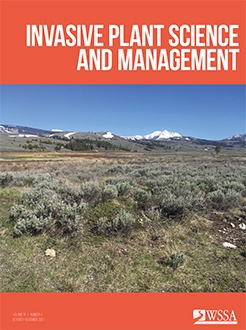Pale swallowwort [Vincetoxicum rossicum (Kleopow) Barbar.; syn.: Cynanchum rossicum (Kleopow) Borhidi] and black swallowwort [Vincetoxicum nigrum (L.) Moench; syn.: Cynanchum louiseae Kartesz & Gandhi] are invasive perennial viny milkweeds that have become prevalent across natural and managed habitats in northeastern North America. Southern blight of V. rossicum caused by the fungus Athelia rolfsii (Curzi) C. C. Tu & Kimbr. was reported at a New York county park in 2008, resulting in a decline in V. rossicum stands. The disease outbreak and persistence of the pathogen highlighted the potential of A. rolfsii for Vincetoxicum spp. control. To better characterize A. rolfsii's pathogenicity and biology, we studied virulence to adult Vincetoxicum spp., spatiotemporal attributes of the Southern blight epidemic at the discovery site over 4 yr, and sclerotial survival over 2 yr. Disease incidence and severity were high for both Vincetoxicum spp. in misting chamber experiments. The spatiotemporal spread patterns of Southern blight in V. rossicum suggest the epidemic in the first year of monitoring (2016) was already highly aggregated and that subsequent spread was limited and resulted in significant local aggregation. Sclerotial survival studies at two locations (Pittsford and Ithaca, NY) demonstrated the A. rolfsii isolates can overwinter in upstate New York and are pathogenic to Vincetoxicum spp. the subsequent season. However, shallow burial of sclerotia more rapidly reduced survival compared with placement on the soil surface. Overwinter survival of A. rolfsii sclerotia in New York is notable, as this pathogen is typically associated with subtropical and tropical regions. Broadcast applications of the pathogen would be needed for widespread Vincetoxicum control at a site, but even restricting releases to select locations would not prevent pathogen movement off-site via water or machinery. The known risks of the A. rolfsii isolate to other broadleaf plants in natural and agricultural settings suggest a low feasibility of use for the biological control of Vincetoxicum spp.
How to translate text using browser tools
22 November 2021
Southern blight of perennial swallowwort (Vincetoxicum spp.) in New York
Sarah J. Pethybridge,
Sean Murphy,
Sandeep Sharma,
Jeromy Biazzo,
Lindsey R. Milbrath
ACCESS THE FULL ARTICLE
Athelia rolfsii
dog-strangling vine
invasive plant
natural areas
sclerotia
Sclerotium rolfsii






